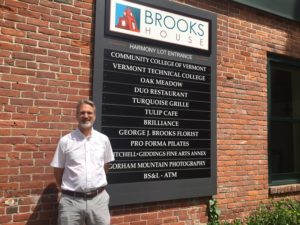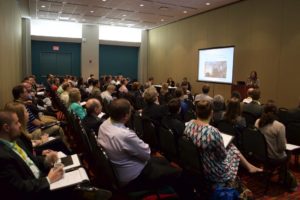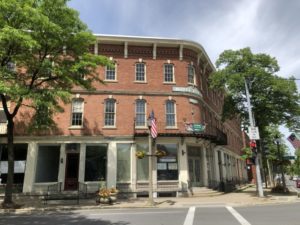With the final funding piece finally in place, the Bennington Redevelopment Group (BRG) in early August held a groundbreaking ceremony to celebrate the start of construction on the $31 million revitalization of the historic Putnam Block. Phase I will transform three historic buildings at the Four Corners in downtown Bennington into a vibrant urban hub.
Vermont Governor Phil Scott, Congressman Peter Welch, project funders, investors, and supporters, among many others, joined in the long-awaited event held under a large tent next to the Oldcastle Theatre at 331 Main Street.
Crucial to this redevelopment, like the one at the Brooks House in Brattleboro, was a complex and hard-won financing package that brought together both public and private investors. The state also has committed about $3 million to the project.
Promoters hope to have Phase I ready for occupancy by late 2020. About 70 percent of the space in Phase I is leased, and 30 percent of the 30 apartments are spoken for.
Phase I of the Putnam Block revitalization will include the redevelopment of the historic Hotel Putnam, Old Courthouse, and Winslow Building, as well as site improvements to the property.
In addition to renovation of the three buildings in the National Register listed Historic District, Phase I encompasses demolition of structures, environmental cleanup, and the creation of parking and mixed-use office, residential, and retail space.
When Phase I is completed, the Putnam Block will include 78,000 square feet of renovated space and 30 new market rate and income-qualified apartments which are expected to draw over 50 new residents to the downtown while creating hundreds of construction and permanent jobs for the area.
“The conversation about the Putnam Block Redevelopment Project has a long history but really gained momentum in 2016,” said Jim Brown, President and CEO of The Bank of Bennington. “We watched our Main Street empty out with vacant store fronts and upper stories. Our businesses struggled to not only attract workers but retain the ones they had. It became obvious to us that the only way to reverse our negative trend was to be bold and invest in ourselves – the community and its future generations – by reimaging the downtown.”
Community and civic leaders, institutions, and inspired individuals banded together to create the Bennington Redevelopment Group, LLC (BRG) with the express goal of revitalizing Bennington’s downtown.
Governor Phil Scott said: “What an exciting day. You know I have the opportunity to go to a lot of ground-breakings, ribbon cuttings and so forth. This has to be the largest I’ve been to since becoming governor, and probably before that as well, and it’s a testament to what this project means and all the hard work that went into it and those who are investing in it and not just in monetary value. It’s about investing in what we believe in here in this region. So I thank you for coming today. First of all congratulations to the community, the region, and all the members of the Bennington redevelopment group.”
“The Putnam Block is one of the most important economic development initiatives under way in Vermont right now.”
“The fact is we need to give a helping hand to our economic centers outside of Chittenden County. Places like Bennington, Brattleboro, Rutland, Springfield and many others in order to re-energize our rural communities. Big projects take vision, they take commitment, they also take of course a little bit of money.”
“Not long after becoming governor, I was brought up to speed on the importance of the Putnam Block and the role it plays in revitalizing the region.”
“I’ve seen and heard such great things about these efforts, like the work that Bill Colvin, Bob Stevens and others were doing to line up funding sources and I learned about why they were doing it.”
“I know many of you have heard from folks like Tom Dee and Jim Brown from the Bank of Bennington who share these reasons as well.”
“Simply put, regional economic centers, hubs like Bennington, need game-changing projects that support economic growth in long-term economic security.”
“On my first day in office two and a half years ago I signed an executive order that laid out the three top priorities of my administration to grow the economy, make Vermont more affordable, and protect the most vulnerable. These are as important today as they were then.”
“The Putnam Block addresses each one of these priorities and it takes partners like Vermont Rural Ventures, who stepped up to provide one of the largest New Market Tax Credit allocations in its history.”
New Market Tax Credits allow for private, individual investment in community projects.
The governor also mentioned the impediment affordable housing is to economic development across the state and the recent housing bond, the state’s first, for $37 million that will leverage $65 million. Some of that money will be used for the housing component in Bennington.
The BRG members, which include The Bank of Bennington, Southwestern Vermont Health Care, Bennington College, 4 Putt Properties, Tony and Jackie Marro, M&S Development, Sheela Harden, Elizabeth Harden, Dimitri Garder, Brian and Jennifer McKenna, Deborah Wiley, and Ira Wagner, seized on the Putnam Block as the catalytic key to their new initiative.
With M&S Development on board as lead development consultant, the BRG members joined forces to rejuvenate the area and to bring amenities into the downtown, such as access to fresh food and medical services.
“This project demonstrates what’s possible when a community with a vision and determination comes together to revitalize the heart of their downtown,” stated Tom Dee, President and CEO of Southwestern Vermont Health Center. Dee continued, “I am incredibly proud of what this group and this town have been able to achieve thus far, and grateful to all of our partners for helping to get this project to where it is today.”
“Today, we celebrate the kickoff of this historic project that will revitalize downtown Bennington. We also celebrate the extraordinary efforts of the community leaders who brought their vision to life in the face of countless obstacles along the way. I am particularly pleased that the federal New Market Tax Credit played a vital role in this vibrant project and look forward to returning to celebrate its completion,” said Congressman Peter Welch.
“(Some) said this economic development project of $56 million dollars didn’t make economic sense,” Welch said. “But you know what? It makes sense for Bennington. It makes sense for our kids. It makes sense for the future of small-town America and at the end of the day it’s going to make sense economically as well. Because it’s only by investing in where you live, putting that stake in the ground, committing yourself to a future, doing the hard work that it takes to build this community and to say that that anchor building is going to thrive again, rather than wither and die. That makes spiritual sense. It makes community sense. It’s what we must do.”
“As an equity partner in this project, as well as lead development consultant, M&S is thrilled to have helped make Putnam a reality. The fact that we were able to secure over $15.2 million in grants and tax credit funding for this project from so many great partners is a testament to the importance of the work being done here. We are very proud to finally see shovels in the ground today – this is truly a great day for Bennington,” said Bob Stevens, Principal, M&S Development
The BRG has now transitioned to planning for and funding the second phase (Phase II) of the project.
Phase II will consist of a newly constructed building intended to house additional retail spaces, offices, housing, and much needed medical and training facilities. Phase II would entail about 55,000 square feet of new construction and the remaining 60 percent of the site work, including most of the parking, all of the municipal infrastructure, and the remainder of the environmental cleanup.
Phase II also hopes to use tax incremental financing (TIF district), which makes downtown projects more financially viable for potential developers.
TIF Districts have been employed and made significant impacts in places like Winooski, Milton and St Albans, but have also been questioned about the implementation of the law and its long-term property tax implications. State Auditor Doug Hoffer in August issued a report questioning how the TIF was used in the development of the new hotel in St Albans.
Governor Scott has praised the TIF program and local municipalities have welcomed its implementation. The Legislature will likely revisit and tighten up the law.
A future third phase in Bennington, for which land has been banked with Housing Vermont, a non-profit housing developer, will develop an additional 30 housing units. With the support of the BRG, the Bennington County Industrial Corporation (BCIC), the local non-profit regional economic development corporation (RDC), purchased from the Greenberg family nearly all the buildings and land which make up the Putnam Block.
With federal funding from the EPA through the Windham Regional Commission and the VT Agency of Commerce & Community Development, BCIC then undertook the Brownfields environmental cleanup necessary to ready the properties for private ownership which would place the property back in service. (RDCs in Vermont benefit from certain protections related to environmental liability.)
According to Bill Colvin, Executive Director, BCIC, the financing package was very complex, with an unprecedented number of funding sources and investors.
The project received early development funding from the Vermont Community Foundation, and over the past three years the BRG worked with M&S Development to structure the deal to comply with the Federal Historic Tax Credit and New Markets Tax Credit programs, among others, and to attract tax credit allocation.
Ultimately, this allocation came from Vermont Rural Ventures, Mid-City Community CDE, an Urban Atlantic Development subsidiary in Bethesda, Maryland, and Mascoma Community Development in Lebanon, NH, while tax credit equity came from US Bankcorp Community Development Corporation.
Senior debt was provided by Mascoma Bank, with junior debt supplied by Vermont Economic Development Authority.
The project also received funding support from the Putnam Block Opportunity Zone Fund, Inc; the Vermont Community Development Program; the Vermont Downtown and Village Center tax credit program; Vermont Housing & Conservation Board; People’s United Bank; The Bank of Bennington; VT Agency of Natural Resources; Vermont Mutual Insurance Group; Efficiency Vermont; Vermont Energy Investment Corp; Preservation Trust of Vermont; Citizens for a Greater Bennington; the Town of Bennington; and nearly 20 individual investors from the Bennington community.
The Putnam Block Redevelopment Project is intended to act as a catalyst for economic and community development in southern Vermont and to serve as a replicable model for rural downtowns throughout the state.
“Across rural America, we are watching as our downtowns are challenged by demographic shifts. Vermont is no different,” said (former) Secretary Michael Schirling of the VT Agency of Commerce & Community Development. “We look for creative solutions to enable our communities to remain vibrant or experience a resurgence. The Putnam Block Redevelopment Project provided a solution for Bennington through community-led development. Businesses, institutions, citizens came together to act as developers to reinvigorate their downtown and shape its future, and their own.”
The project is working with Stevens & Associates as lead design professionals and Bread Loaf Corporation as lead construction managers.





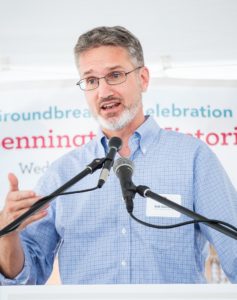 For more information and registration visit:
For more information and registration visit:  Join Skye Morse, Principal and Investment Director at
Join Skye Morse, Principal and Investment Director at 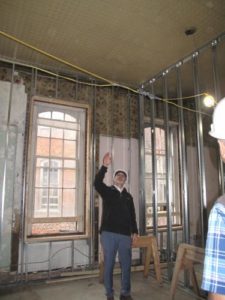
 Join Skye Morse, Principal and Investment Director for M&S Development at the Urban Institute –
Join Skye Morse, Principal and Investment Director for M&S Development at the Urban Institute – 